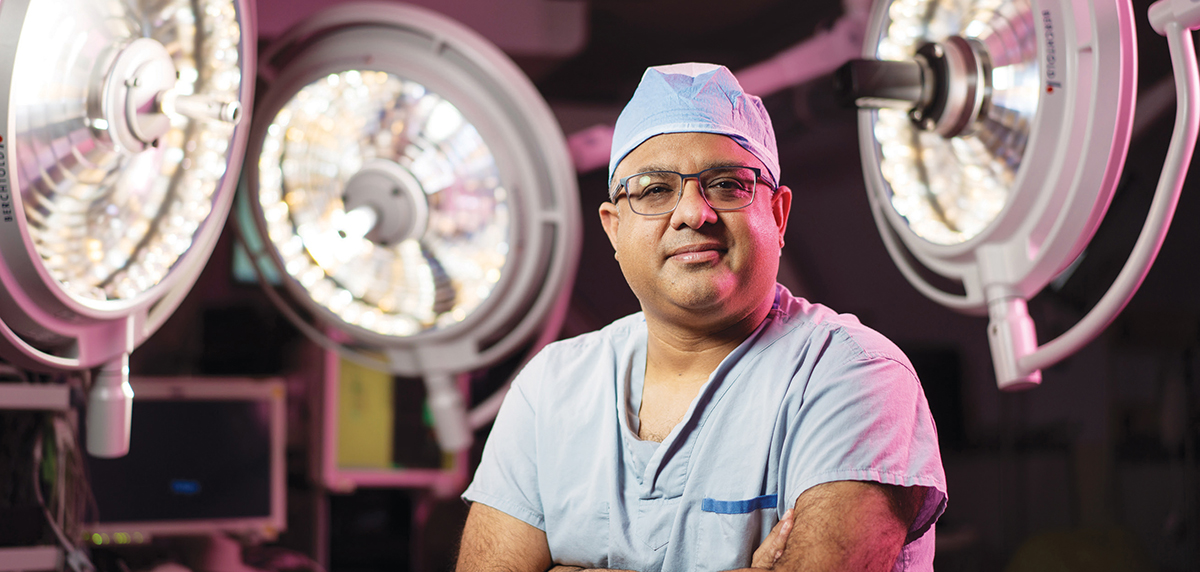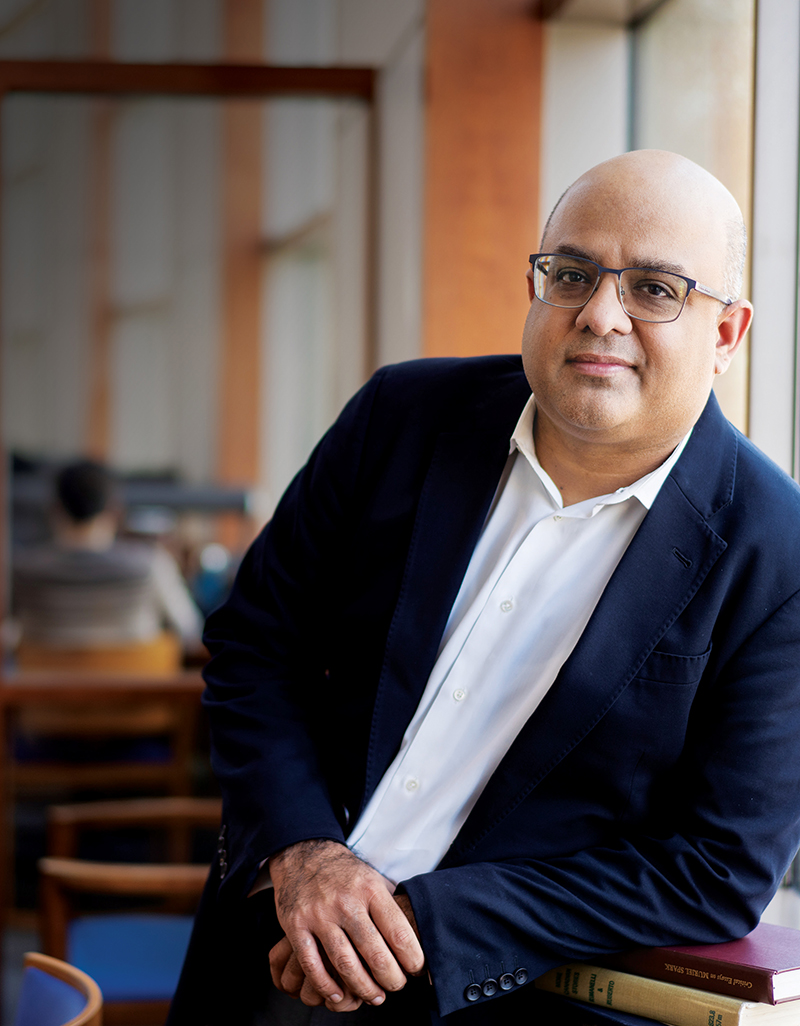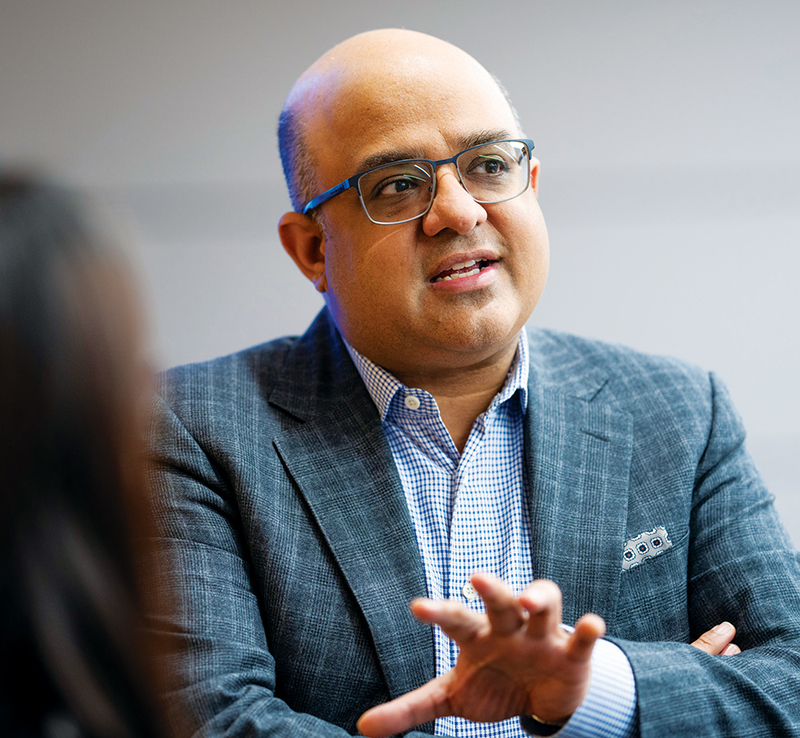Dr Ahmer A. Karimuddin
Dr Karimuddin started his 1-year term as president of Doctors of BC on 1 January 2024. He spoke with BCMJ editor-in-chief Dr Caitlin Dunne in December.

Congratulations on being elected the new president of Doctors of BC. I learned a lot about you from your personal website, www.drkarimuddin.com, and I would encourage readers to have a look. Why don’t you start by introducing yourself to the readership?
I come to this role having worked for 15 years in BC. As a colorectal surgeon, my practice is predominantly at St. Paul’s Hospital, where I’ve looked after a population of patients sent to me by colleagues around the province. My other big role is in medical education. I’ve been program director of our general surgery residency program for the past 6 years, which is very fulfilling.
Along with that, I have a family with four kids. My oldest is in grade 12 and applying to university this year—last night I helped him with his university applications; we’re working out the essays he’s writing. My wife is an English teacher in Richmond, where we live.
If you read my website, you saw that I’ve worked in many spaces with Doctors of BC, so this space isn’t alien to me. I was president of our Section of General Surgeons, which we call the General Surgeons of BC. I was on the Tariff Committee and chair of the Specialist Services Committee.
You’re being modest; I see you’ve also won many awards and published a lot of research. How does somebody with so much on their plate decide now is the time to jump into taking on the presidency?
I had no plans to do this until 5 days before the nominating deadline. My feeling toward medical politics and advocacy has always been what can you do to make health care and the spaces you work in better, whether that’s hospitals or clinics. That’s been my lens, and I wasn’t convinced that being president of an organization like Doctors of BC would serve that kind of broader purpose. It seemed a little too meta, a little too removed. What helped me make the decision was colleagues reaching out to say that health care has been in a difficult position for physicians. Doctors have had a hard time coping with the postpandemic world, dealing with challenges in our facilities, with emergency room wait times, and with ever-longer wait lists, which I’m sure you deal with in your practice. The feeling I got from a lot of people was that they were at their wits’ end, there was no other path forward, and they were going to continue to feel stressed and distressed for their patients and not be able to do much about it. That didn’t sit right with me; my feeling is there’s always hope as long as you work your way forward. The idea of talking to our colleagues around the province, hearing their stories, and helping them find a way forward in these difficult times seemed like something tangible and material for me to do, both as a surgeon and as someone who’s committed to the hard work of research and quality improvement. Over 1 week, I transitioned to thinking this might be a good idea given the state we’re in, and over the past year, for me as a facility-based physician, someone who has spent their life with a collaborative, quality improvement lens on things, thanks to the conversations I’ve had, it has seemed like the right decision.
What I hear is optimism. A belief that we as doctors can impact the systems in which we work toward positive change. That seems like a heavy lift right now. As you come into this job, what’s your approach to spreading that optimism to get more people helping you on that journey?
I can start at the micro level. In our work as physicians, we make a difference in innumerable patients’ lives daily. On a busy clinic day, I’ll see between 30 and 35 patients, and I’d like to think I make a positive difference in the majority of their lives. If you expand from that to the entire health care system, it’s nothing more than a sum of its parts—physicians, patients, and other health care providers. We know the challenges our patients face. We know the challenges our colleagues face. Something past president Dr Joshua Greggain might have said that I’ll repeat is that the only thing that’s ever changed anything in the world is a group of committed people committing to make a difference along a common path. When we decide what we’re going to work on, what’s going to be important, how can that group of people not make a difference? I would challenge anyone who says things are too dark and heavy to lift to think, yeah, they are, but that’s not a reason to stop working.
I see you won an award for your role as residency program director. What do you say to the young doctors soon to become general surgeons to inspire them in this current environment?
That’s a great question, and thank you for phrasing it that way. How we inspire our trainees is the true testament to where our profession is and what our values are.
Just yesterday I had a resident say to me that it’s a tough time to be a doctor, people don’t trust physicians, and people don’t feel physicians are doing the right thing for them. And I said, you’re right, as a whole, patients have less and less trust in the health care system, and patients are worried about how the health care system can look after them, but they don’t distrust the physician who is looking after them. The best way to serve the profession and make health care better for the population is to do the best job you can for the patient who is in front of you. Are you being an advocate for that patient? Are you doing your best for them in that moment? If the answer is yes, I’ve done the best I can given the restrictions I have around me; that’s all anyone can ask. I know it’s a high bar to hold, but that is both the solution and the inspiration for many of our challenges in the health care system.
 That resonates with me. Patients are broken in body and they’re broken in heart. Do you think we prepare our residents as much for the latter?
That resonates with me. Patients are broken in body and they’re broken in heart. Do you think we prepare our residents as much for the latter?
No, I don’t think so. Most of us have been trained in a pathophysiological basis of disease and we think if we fix the broken body part, then automatically the heart will mend. I think, both in your work in reproductive endocrinology and the work I do, we know that’s not true.
The journey can be very, very taxing. And we forget the human cost of the journey a cancer patient goes through, for example, or a patient struggling with diabetes or another medical condition. That journey needs to be acknowledged. When our patients tell us they’re upset that they waited a long time or they’re upset that their care was delayed, we need to acknowledge that and say, that’s right, the system let you down. But in this moment, I’m not going to.
When we talk about what we can do for the system and what should give us hope, it is that eventually, if we all keep doing our best for the patient in the moment, the system will work. That might mean us working differently, or working in teams, or trying to figure out other strategies to get the work done. But we can do it. We have a lot of resources in Canada.
I love that—the system has let you down, but in this moment I’m not going to. Speaking of resources—this is something women are often asked, but it’s not often asked of men—you have four kids, your wife has a career, and you have a busy practice and obligations to patients; how are you going to balance your work and your family during this additional step in your career?
Balance is difficult to figure out in our type of life, right? As physicians we’re pulled in many directions, both in our jobs and in the leadership roles we have in our communities. My first step toward balance has always been to try to only do things that give me joy. If it’s doing research and working with residents, I’ll choose projects I’m excited by. When we did work on patient-reported outcomes or recovering from major abdominal surgery for inflammatory bowel disease, that gave me joy to do.
Almost all the committees I’ve been on at Doctors of BC and the Specialist Services Committee were places where I felt I was making a difference, and that gave me joy. When I was asked to consider this role, I talked to my wife and my partners at work to ask if we could make this work.
My wife’s first questions were: Is this something you will enjoy doing? Is it going to be fun? Are you going to grow? And I said, I think so, so she was very supportive. From my colleagues’ perspective, I’m decreasing my clinical practice by 50% for the upcoming year to serve in this role. It’s the first time as a surgeon I’ve done that. This will resonate with you as a surgeon as well; putting down on paper that I’m going to work 50% of my regular hours was one of the harder things I’ve ever done, but that’s how I’m going to create time and capacity to represent the 17 000 BC physicians and tell their stories.
You mentioned the Specialist Services Committee, the SSC. I didn’t learn about it until I’d been a specialist for a number of years. What would you like specialists to know about the SSC?
I’ll take a step back and talk about why the SSC is an important space. As physicians, we know it takes a group of people to provide one patient the care they need. As a surgeon, there’s nothing I do in the hospital that doesn’t require 100 people, even the most minor surgical procedure. But somehow we think the way to change the health care system is by standing alone in an office saying listen to me, this is the right thing to do, everybody should do it. We’re willing to have 100 people involved for an individual patient, but to change the health care system we think one passionate physician can do it on their own. That’s not how it works. We need all stakeholders at the table to leverage change for patients, which can include health authorities, people from the Ministry of Health, other physicians, and affiliated health care providers and nurses. That’s what the SSC provides. Around a collaborative table, we can have people from the Ministry of Health, specialist colleagues, the health authorities, and operational leads all talking about what matters to us and offering solutions from our different perspectives. As physicians, we know what happens to our patients day to day, but our administrators know what happens on a larger scale and what challenges the system is facing. That’s the big-picture reason why places like the SSC, and collaborative tables in general, matter.
The SSC is also a space for quality improvement in the province. There are 5000 physicians around the province who have trained in quality improvement methodology through the SSC. And that’s the Institute for Healthcare Improvement quality improvement initiative. Funding and training to learn that methodology is available through health authorities and through a community-based specialist’s lens. There is also leadership training akin to many of the leadership programs offered through Harvard and Yale; that’s offered through the UBC Sauder School of Business, and I think about 1500 physicians around the province have completed that. There are opportunities to not only help patients, but also grow yourself and learn new things about how health care works and how we can make health care better.
On your profile, and in your statement for Doctors of BC, you also talk about diversity, equity, and inclusion, particularly with respect to people to whom our society is unfair or unjust. You are mid-career; looking back over your career in medicine, how have you seen that evolve?
When I started practising 15 years ago, the first literature came out showing that people of lower socioeconomic status and people of color had differing clinical outcomes. The first paper showing that Indigenous patients had worse surgical outcomes across North America was, I think, published in 2011 or 2012. But we didn’t talk about differing outcomes. We continued to live in the Pollyanna dream that, in Canada, because we’ve got universal medicare, everybody’s looked after, regardless of their background, regardless of their socioeconomic status. We now know that’s not true. If you think about how far we’ve come in that amount of time, it’s actually a phenomenal leap. When I did my residency training from 2001 to 2007, the idea of different socioeconomic status having an impact on outcomes wasn’t talked about. We talked about how that might influence access or perceptions of disease, but no one talked about outcomes. We now know as a matter of fact that there are glass-ceiling effects that affect women and people of color—in both the Canadian and the North American health care systems—from a career-progression standpoint for physicians, and we know that clinical outcomes are different for people of color and lower socioeconomic status. I’ve been privileged to work with colleagues in the UBC School of Population and Public Health, where we’ve shown that data to be true in BC. Acknowledging that is the first important step to figuring out how we’re going to make things better. Our biggest health care system challenge moving forward will be holding ourselves accountable to deliver the package of care a patient needs regardless of their socioeconomic status, cultural background, or Indigenous status—simply because they have a problem. And I’d like to challenge each of us as physicians to do that in our daily practices.
 What I’m learning is that it’s about meeting patients where they are and understanding the culture they come from, the beliefs they hold, and the society in which they live their lives, and then trying to make that part of the bigger picture. It’s not a one-size-fits-all approach. Illness is more than the disease that we see in front of us.
What I’m learning is that it’s about meeting patients where they are and understanding the culture they come from, the beliefs they hold, and the society in which they live their lives, and then trying to make that part of the bigger picture. It’s not a one-size-fits-all approach. Illness is more than the disease that we see in front of us.
That’s a great point—asking patients what’s important to them and what they want their care journey to look like. You probably do that in your practice, but even in my practice in colorectal surgery, when we talk to patients about permanent ostomies and disfiguring surgeries, we ask what is important to them. Maybe they’re from a small community an hour and a half away from Bella Bella, so as we’re looking after them, we ask if having care at home is what’s important; being in Vancouver for 6 months while going through the package of care can be onerous.
In the past we didn’t ask those questions because we had a pathophysiological approach to disease—that’s what the guidelines say, so that’s what we’re going to do. We’re realizing there are no guidelines; there’s just the patient sitting in front of us and what they want in that moment.
How about when you look forward? What will a successful term look like for you?
There are two parts to that. Philosophically, I feel that whenever someone is talking about physicians or our patients, we need to be in the room—nothing about us or about our people without us. I’m realizing more and more that in our current health care system, physicians are often not in the room when big decisions are made. That’s the message I want to take, on behalf of our members, to people in the health authorities and the Ministry of Health. If I can increase the number of physicians in the room when decisions are being made, I think that will be a win.
For the other part, I don’t think physicians have ever felt more alone in the work they do. When working against resource challenges or demands on our time, we feel as if we are each the only ones struggling with it. We need to get past that. Just as we involve colleagues to help us with patients and when we need consultations or advice, when we’re struggling, we need to ask our colleagues for help and advice about how to navigate that. Dr Greggain often talked about better together being his motto for what he wanted to work on in his year; I’ll add an addendum to that. Yes, we are better together, but also, we are never alone. And if we are feeling alone, whether because our biases make us feel that way or because our desire to be autonomous freaks us out and tells us we are alone, we need to realize we’re not. Whenever I reach out for help, someone’s always there.
hidden
 |
| This work is licensed under a Creative Commons Attribution-NonCommercial-NoDerivatives 4.0 International License. |
